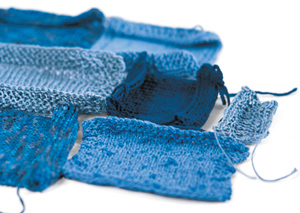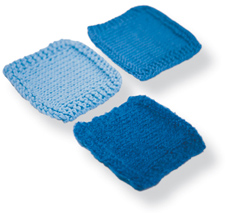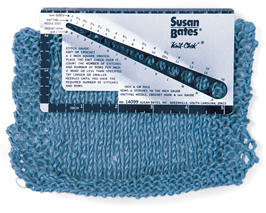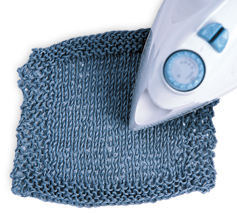How do the experts care for their fine knitted items? We spoke with representatives of several yarn companies, who were happy to share tricks of the trade.
The industry insiders interviewed for this article have one thing in common: all emphasize the importance of knitting a gauge swatch, then blocking it in the same way as the final garment. Says Barry Klein of Trendsetter Yarns: “Always knit a swatch and keep it; don’t rip it out. Use it not only to determine the gauge but also to test how you’ll block and clean your garment.”
A blocked, or dressed, swatch will give you the true stitch and row gauge for your knitted fabric (certain stitches, such as lace and cables, change dramatically after blocking); as well, it provides valuable information about the drape of the yarn, and lets you know how the yarn will react to moisture. Cashmere, for instance, softens after washing, and its stitches “bloom” (that is, fill in). Other fibers too change their character or gauge. Notes Margery Winter, creative director of Berroco, Inc.: “After blocking, [some] linen yarns undergo a big change—the length and width of the blocked swatch differ substantially from the measurements on the needle. The only way to determine the gauge is from the blocked swatch.”
HANDLE WITH CARE
Yarn manufacturers urge knitters to follow their recommendations for cleaning and blocking. If other methods are being considered—ones that involve steam, heat or any other action that’s inconsistent with the yarn’s care label, for instance—it’s doubly important to do a test. For example, knitters must use caution with synthetics (some may melt), natural fibers such as silk, and fibers that can scorch, like cotton and rayon.
Many fibers—protein, plant and manufactured—can be hand-washed safely. In fact, animal fibers generally benefit from hand-washing, which removes dirt and oils trapped during the manufacturing process. It’s the type of dyes used, and how those dyes interact with the fibers, that determines whether a particular yarn should be washed. (Dyes can often be “set” by adding a tablespoon of white vinegar to water.) Again, test first on a swatch. When working with yarns that are blends of multiple types of fibers, follow the instructions on the ball band.
KINDS OF BLOCKING
Barry Klein considers blocking an essential part of the knitting process. To begin, he wet-blocks a square by spraying the fabric with water, shapes it, pins it and lets it airdry. To protect the garment, he places the fabric right-side down. Interestingly, a number of yarns—Trendsetter’s polyester eyelash for one—should not be blocked at all; instead, he says, just shake them to fluff.
Margery Winter concurs: “I never block [Berroco’s] faux-fur ‘Zap.’ It’s sufficient to tease it with a knitting needle and shake it to fluff the fabric.” She also skips blocking when the stitch quality of the finished piece is consistent, edges don’t curl and the measurements are exact. She adds that some yarns, such as “Plush,” don’t need blocking because they are completely square and finished right off the needles.
Blocking evens out the most irregular stitches and prevents edges from curling.


However, Winter hard-blocks garments made from wool, or those with a high percentage of wool or other animal fibers, after assembling them, because hard-blocking evens out and aligns stitches. She hardblocks linen by dampening it, then steamironing it through a pressing cloth. She also hard-blocks cotton and silk blends but cautions knitters to use extra care when blocking silk.
Chuck Desmond, manager of the Jagger Spun Division at Jagger Brothers, Inc., blocks garments right-side up and always wet-blocks items knitted from animal fibers. She recommends briefly soaking garments in water, spinning them without agitation to remove excess moisture, then blocking. Like many of those we spoke with, she suggests placing delicate items such as lace shawls in lingerie bags before spinning so they don’t catch on washing machine parts.
Nancy Thomas, editorial director of Lion Brand Yarn, has a different philosophy when it comes to blocking. “Years ago there was a move to more careful blocking: pinning to exact specifications and hard finishing. But with the proliferation of more yarn blends, heavy blocking is no longer as necessary.” She doesn’t steam garments made from blends of manufactured and animal fibers, and yarns such as Lion Brand’s “Glitterspun” don’t need blocking at all. Usually, she just sews garments together, though she may lightly spray them with water. Thomas steam-blocks seams from the inside of the garment and does other blocking from the outside.
CLEANING KNITTED GARMENTS
The following instructions apply to all of the fibers for which hand-washing is recommended. (Remember: Protein fibers and silk are most vulnerable when wet.) Fill a clean basin with cool to tepid water and a gentle cleanser made specifically for washing wool and other fine fibers, or a gentle PH-neutral, dye free detergent. Gently squish the water through the garment—never twist or wring—and let it soak. Let the water out of the basin and, supporting the fabric with your hands, gently press it against the sides and bottom of the bowl to remove excess water. If the detergent needs to be rinsed out, refill the basin and repeat the process. Place the garment in a washing machine (use a lingerie bag if necessary) and briefly spin without agitation to remove much of the excess water. Support the garment when you remove it, shape, and lay flat to dry.
HOW THE EXPERTS DO IT
Chuck Desmond uses Eucalan, a PHneutral, biodegradable cleansing agent that doesn’t need rinsing, for items made from animal fibers. Because protein fibers should not be wet for long periods of time, she briefly spins them in a washer. For tough stains that are embedded in the fibers, such as oil and grease, she recommends dry cleaning.
Some yarns can be trickier to clean. For example, Desmond notes that Jagger Spun’s lace-weight wool/silk “Zephyr” should be dry-cleaned, because wool and silk fibers handle dye differently. (Dyes tend to sit on top of silk fibers and may be less resistant to fading in light and water than pure wool.)
For hand washing garments, Barry Klein recommends using a mild dye-free detergent such as Dreft or Ivory Snow (some harsh detergents, including Woolite, contain acid). He adds: “Put a little Vidal Sassoon finishing rinse in the final rinse water when washing mohair to soften it up. But always test this on your swatch first.” He notes that garments made from multiple fibers can be safely “air fluffed” in a dryer without heat; in some cases, low heat may be used.
Like Chuck Desmond, Nancy Thomas prefers a no-rinse wool wash. She fills her washing machine with water, adding wool wash as it fills, and lets her garments soak for half an hour. She then spins most of the water out, not allowing the machine to agitate. Occasionally she’ll place knitted items such as afghans in the dryer for a few minutes, at a low temperature, to help eliminate some of the moisture. Thomas also recommends placing items that can be damaged by the spinning motion of a washing machine in a pillowcase or lingerie bag for protection.


STORAGE
All of the yarn company representatives stress the importance of making sure garments are absolutely clean before they are stored, because moths, carpet beetles and other fibereating pests are attracted to stained fibers. Make sure too that they are perfectly dry: damp fibers will mildew and rot. Margery Winter stores knitted items in ventilated plastic hampers in her closet, with tissue paper between the layers. Chuck Desmond folds garments flat and places them between acid-free tissue paper (available from dry cleaners) in a cedar chest or in plastic sweater boxes with a cedar block or chips near them (a cotton ball soaked in natural lavender oil also works). “Clothes should not be kept in plastic bags, but plastic sweater boxes will allow some air circulation,” she notes. Always store clothes made from natural fibers away from light.
Barry Klein recommends storing knitted garments on a shelf in a dark corner of a closet. He says that zippered bags should never be used, nor should any garment be placed inside sealed plastic, because animals fibers (wool and the like) need to breathe or their characteristics will change. If there is a concern about moths or other fibers-eating pests, a piece of cedar may be hung in the closet.
When in doubt, consult with your dry cleaner for ideas about the long-term storage of special garments.
BLOCKING AND CLEANING RECOMMENDATIONS
These recommendations are based on information from a variety of sources, including Principles of Knitting, by June Hemmons Hiatt; Vogue Knitting: The Ultimate Knitting Book, from the editors of Vogue Knitting; and other highly respected sources, including trade association Web sites.
Note: The recommendations apply to yarns that contain only one fiber, or fibers with compatible care methods. If the ball band specifies a cleaning or blocking method that differs from the one recommended below, follow the care instructions on the band. Where hand-washing is recommended, refer to the instructions herein.
PROTEIN FIBERS
ALPACA Hand-wash. Blocking: Steam-block or damp (wet) block
ANGORA Hand-wash. Blocking: Wet-block by spraying
CASHMERE Hand-wash (this fiber is more susceptible to alkalis than wool; use extra care when washing). Blocking: Wet-block, or dryblock with steam (test temperature on swatch)
MOHAIR Hand-wash. Can be briefly air fluffed in a dryer without heat. Blocking: Wet-block by spraying
WOOL Hand-wash; can be machine-washed and-dried if labeled “superwash.” Blocking: Wetblock, or dry-block with warm steam
PLANT FIBERS
COTTON Machine-washable using soap or detergent; can be machine-dried, which will help restore its original shape. Completely dry before storing. Blocking: Wet-block, or block with steam. Use caution—scorching will occur if steam is too hot.
LINEN Can be washed with non-alkali soap or dry-cleaned; can also be dried in a hot dryer, then ironed. Dry completely before storing. Blocking: Wet block, or dry-block with warm or hot steam.
SILK Hand-wash using a PH-neutral detergent, or dry-clean. If appropriate, use steam and a moderate iron temperature. Note: Moisture weakens silk fiber. Blocking: Steam-block at a moderate temperature setting; be sure to test on your swatch
SYNTHETICS PRODUCED FROM WOOD PULP
RAYON Wash with a mild PH-neutral detergent; alkalis and dry heat can cause damage; will scorch if the heat used to press it is too high. Rayon weakens when wet and must be dried completely before storing. Blocking: Wet-block by spraying, unless contraindicated by ballband instructions.
LYCOCELL Lycocell—trade name Tencel—is a manufactured fiber made from cellulose (wood pulp), using a process different from that used for rayon. Found in many yarns, Lycocell can be hand- or machine-washed and dry-cleaned; the fibers with which it is combined determine the cleaning and blocking methods. For more information about this fiber, visit www.tencel.com and ianrpubs.unl.edu/textiles/nf350.htm. Blocking: Use the method specified for the types of fibers with which it is blended
SYNTHETICS
Most synthetic fibers, including nylon, acrylic and polyester, as well as metallic yarns, are produced in various ways; recommendations for cleaning and blocking vary. Follow the instructions provided on the ball bands.
